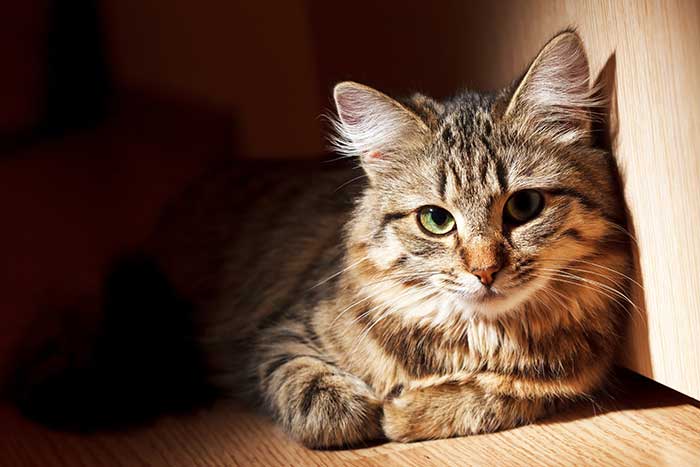Cats are cute and adorable pets. They keep our homes lively with their playfulness, helping us to while away even the dullest days. Therefore, it’s understandable why most cat owners often become restless when their furry, little friends go under the weather.
As a pet parent dealing with a sick cat, one of the questions that you’ll keep asking yourself is, how long can cats go without eating?
Now, a cat can survive for up to a week, possibly more, without solid food, and up to three days without water. However, the answer isn’t as cut and dried as it may sound.
Remember that as starvation and dehydration set in, the cat will become weaker and more vulnerable. As such, it may not necessarily survive for an entire week.
According to professional vets, you should strive to keep your cat hydrated if it doesn’t eat anything for a period of 24 hours, or if it doesn’t drink for up to 12 hours.
Water performs several crucial functions within the body of a starving cat. But most importantly, it enhances the flow of blood to the cat’s vital organs, ensuring those organs continue to function optimally for much longer.
Experts also observe that while a healthy cat can go for up to a week before eating, a sick cat will likely succumb to hunger or dehydration in about two days or so.
Read on for more insights on how long cats can go without food, and many other pertinent questions that relate to the topic.
Table of Contents
Why Do Cats Live Longer Without Food But Shorter Without Water?
As we seek to answer the question, how long can a cat live without eating food, it’s important to begin easy by understanding why cats typically live longer without food than they do without water.
First and foremost, that phenomenon isn’t unique to cats but applies to all other animals. Even humans tend to succumb to dehydration much faster than they succumb to hunger.
Secondly, the body of a cat is composed of 75% water. The water content in your cat’s body can go a little higher or lower than this average. However, you shouldn’t let it go to extremes.

Now, the reason cats live longer without food than they do without water is that they get most of their water from the food that they eat. So, as long as your cat is eating as regularly as it should, the cat will seldom experience the urge to drink.
However, when you realize that your cat isn’t drinking water or eating food, the first prudent thing to do is to establish whether the cat is eating or drinking elsewhere. And the most obvious place to begin your search is at the neighbor next door.
If you’re not feeding your cat properly or offering it enough water, the cat may eventually find a new home in the house of your generous neighbor.
Another place you can check is in the trash can. While humans have domesticated cats for years, these animals haven’t shed all of their primal survival instincts, which include hunting and scavenging.
If you usually chuck a lot of food into the garbage can, you could be inadvertently encouraging your feline friend to eat outside.

If, upon searching diligently, you realize there’s nowhere else the cat is eating or drinking from, then you know you’re dealing with a critical situation. And the problem could be the kind of food or water that you offer to your cat. Cats can be quite picky with food and water.
For instance, most cats detest tap water and instead, prefer running water. That’s yet another survival instinct that cats have preserved for thousands of years.
Remember that even their wild cousins are naturally averse to stagnant water, which they deem to be poisonous. Therefore, you may need to make provisions for running water.
However, if you realize that your feline friend still won’t eat or drink even after offering it water and food, then it’s time to take some radical remedial actions.
Your first instinct would be to take the cat to the vet. But before you do, you should carefully monitor the cat to ensure nothing happens to aggravate its condition.
The following are some of the things that could worsen the situation for a cat that’s not eating or drinking;
1. Refusing to take water or eat even when it’s visibly dehydrated or malnourished;
2. Vomiting and diarrhea;
3. Urinary tract and kidney problems; or
4. Other opportunistic infections.
Which Cats Are Most Vulnerable To Starvation and Dehydration?
As you may have gathered by now, the number of days a domestic cat can take without water or food is quite different compared to their wild relatives.
So, you could be wondering, how long can a feral cat go without eating? And what about stray cats, how long can stray cats go without eating?
Now, a homeless cat may go for a few days without eating or drinking, since there’s virtually no one to feed the cat. With time, their bodies tend to adapt to the scarcity of food, allowing them to make do with the little they can find.
Also, homeless cats are very resilient and tend to look for food in some of the riskiest places to venture, such as hotel and restaurant kitchens.
Due to these adaptabilities, stray cats may live a bit longer without food or water, compared to their domestic counterparts.

Apart from homeless cats, we also have feral cats. Feral cats are highly wild and utterly untamable. Their traits are nearly similar to those of wild cats, both in terms of aggression and survival instincts.
Though you may bump into a few of them scavenging in your trash cans, feral cats almost exclusively live by hunting down rodents and smaller animals. As they feed on the flesh of their prey, they seamlessly drink their blood too.
Therefore, like their wild cousins, feral cats get a lot of water from their food, which means they can go without water much longer than domestic cats.
So, how long can house cats go without eating?
As we’ve already highlighted, when it comes to the risks of starvation and dehydration, the domestic cat is the most vulnerable.
And that’s especially true if the cat doesn’t possess the prerequisite hunting and scavenging skills. Such cats will always rely on the provision of their owners.
It’s worse if you live in an urban setting where there are no rodents or small reptiles to hunt. That would mean the cat exclusively depends on you for its sustenance, and may not last more than a few days without food or water.
Besides the type of cat, there are a few other factors that could determine how long your feline companion survives when faced with hunger and dehydration.
Examples include;
- Age and body size of the cat;
- Health of the cat;
- Accessibility to secondary sources of food and water;
- Weight of the cat;
- The cat’s emotional state;
- Prevailing weather conditions;
- The surrounding; and
- The cat’s genetic heritage.

In terms of age, one frequently asked question is how long can an elderly cat go without eating?
Well, that could range between 2 and 3 days, but it depends on several factors.
As cats age, they tend to lose interest in a lot of things, including food. So, you’ll naturally observe that your elderly cats drink less compared to the younger ones.
But that doesn’t mean it’s okay for older cats to go without water or food, as starvation and dehydration might set in sooner than you can imagine.
The following are some of the symptoms of a starving or dehydrated cat;
- Dry, scaly skin;
- Swollen gums;
- Loss of coordination;
- Lack of grooming;
- Reduced eyesight; and
- Poor cognitive and motor abilities.
Possible Reasons Why Your Cat Is Not Eating or Drinking
We’ve already attempted to settle the question how long can a healthy cat go without eating. However, it’s very important to understand what could be causing your cat to not eat or drink in the first place.
The following are some of these reasons;
1. Lack of flavor in the food
Like humans, cats also tend to associate their food with certain delectable tastes and flavors. If your little furball feels that its food doesn’t taste as delicious as it should, the cat may stop eating the food.
2. Pain when eating or swallowing
Pain when eating or swallowing is another possible reason that could cause your feline friend to stop eating or drinking. Usually, this pain results from inflammation in the cat’s mouth, a sore throat, an injury to its tongue, or decayed teeth.
The best way to establish that either of these is the reason your cat isn’t eating properly is to compare how the cat handles dry and wet food.
Cats with sensitive teeth may experience problems digesting dry food and will choose to avoid the food altogether.

3. Stress
Our feline friends often suffer from various forms of stress and anxiety. An example is separation anxiety, which sets in when the cat’s owner is always gone but doesn’t make provisions for the cat’s mental and physical stimulation.
One of the side effects of feline anxiety is poor dietary habits.
4. Change of environment and routine
Like most animals, cats are creatures of habit. Any slight disruption in their routines is likely to throw them off balance.
If you recently moved homes, you can expect your furball to experience challenges adjusting to its new environment.
And in the process of acclimatizing to its new home, the cat’s eating and drinking behavior may be affected significantly.
Other factors related to change in routine include;
- Bringing a new pet home;
- Change of food;
- Change of feeding or sleeping spot; or
- Home makeover.
5. Side effects of medication or vaccination
If your feline friend was just recently vaccinated, is under prescription medications, or is fresh from surgery, the chances are that the cat won’t eat or drink normally. So, you could be wondering, how long can a cat go without eating after surgery?
Well, that depends on a few factors but most importantly, the intensiveness of the surgery. Vets often recommend a raft of measures to help a cat recover much faster from a surgical procedure, including prescribing appetite-inducing supplements.
6. Certain diseases
There could also be some underlying medical conditions impacting your cat’s ability to eat and drink as it should. But how long can a cat go without eating when sick?
That will depend on the severity of the condition. A day or two, maybe three, for less severe ailments. Perhaps, the more pertinent question should be, what should I do if my cat is sick and won’t eat or drink?
Remember that regardless of the severity of the disease your cat is suffering from, the mere fact that the cat doesn’t eat or drink could compound its woes.
And it’s even worse if the disease is the kind that manifests in symptoms that lead to further loss of water from the cat’s body, such as vomiting and diarrhea. Sadly, you’ll not be able to diagnose most diseases, and your best bet is to take the cat for a professional checkup.

7. You’re dealing with a picky cat
At times, your cat may choose to avoid food and water for no justifiable reasons. Cats are known to be picky eaters, and anything may turn them off in the food. That could be something as trivial as the color or size of their food and water bowl.
Also, most cats are generally averse to skin-irritating plastics, and will typically avoid water or food bowls made of such materials.
Other cats may take an issue with the depth or location of their water bowls. And as we mentioned, cats prefer running and bottled water to tap water.
These reasons may appear trivial, but they could make it difficult for your kitto to enjoy its food and water.
What’s The Worst Thing That Could Happen If Your Cat Doesn’t Eat or Drink?
If your cat doesn’t eat or drink beyond a certain period, it will eventually die. But before that happens, there are several complications to contend with.
The first is hepatic lipidosis, also known as fatty liver disease. This condition causes your cat’s liver to package the fat proteins that are stored within the body, before releasing them to the bloodstream for energy. Obesity is a high risk factor for hepatic lipidosis.
Now, there’s a common misconception that obese cats stand higher chances of survival in the face of starvation and dehydration. In real sense, obesity triggers hepatic lipidosis, making overweight cats that go without food more vulnerable than cats of lean weight.

There are two types of Hepatic Lipidosis, namely;
1. Idiopathic HL: Occurs when a cat stops eating for no apparent reason.
2. Secondary HL: Triggered by an underlying medical condition, such as diabetes, pancreatitis, or a gastrointestinal disease.
Symptoms of hepatic lipidosis include vomiting and diarrhea, muscular weakness and generalized fatigue, drooling, constipation, coordination problems, and jaundice.
Besides hepatic lipidosis, other complications associated with starvation and dehydration include kidney failure and heart failure.
But maybe you’re still wondering, can a cat go 24 hours without food?
Yes, most cats will last 24 hours without food, and you shouldn’t be worried at all. But when your cat goes 2 days without food, you may want to take action as soon as possible. Otherwise, the condition might escalate into any of the above complications.
What to Do If Your Cat Stops Eating?
There are a few remedies you can apply if your cat stops eating or drinking. The following are some of them;
1- Warm the food.
2- Flavor the water.
3- Add the cat’s favorite treat to its food or water.
4- Rotate between dry and wet food.
5- Overhaul the cat’s diet altogether.
6- Visit the vet for further examination.
So, Can Cats Go Without Eating For A Day?
Yes, cats can go a day without food, probably even a week. However, the conventional wisdom is to take remedial measures if your cat goes for 24 hours without eating or 12 hours without drinking.



